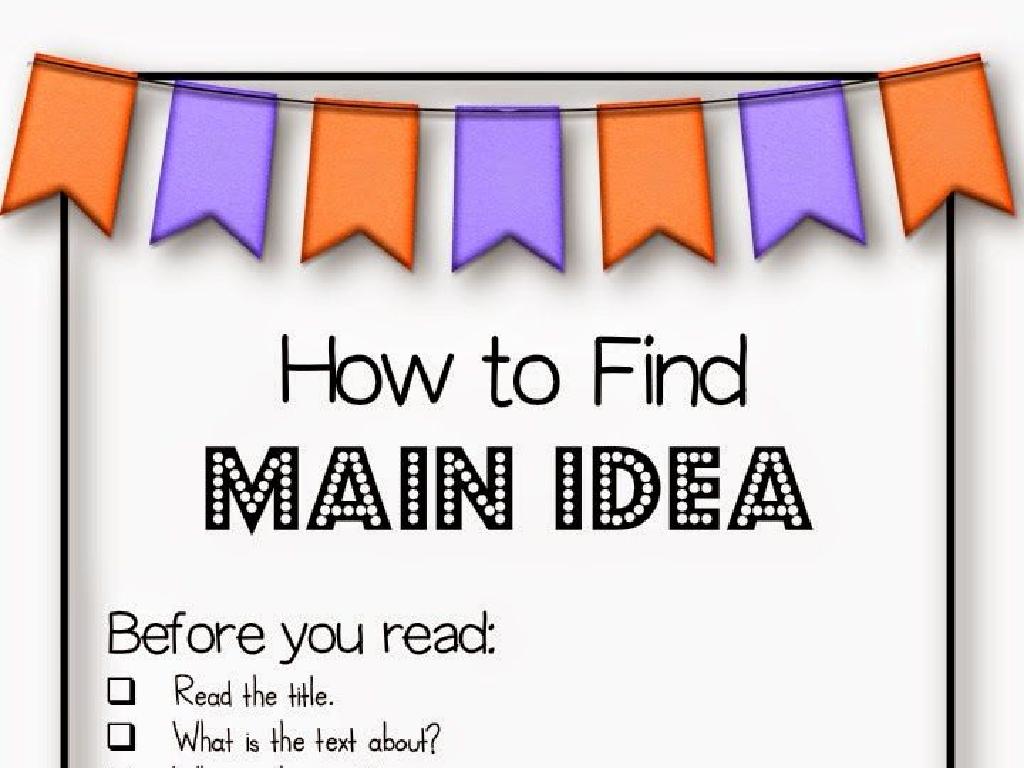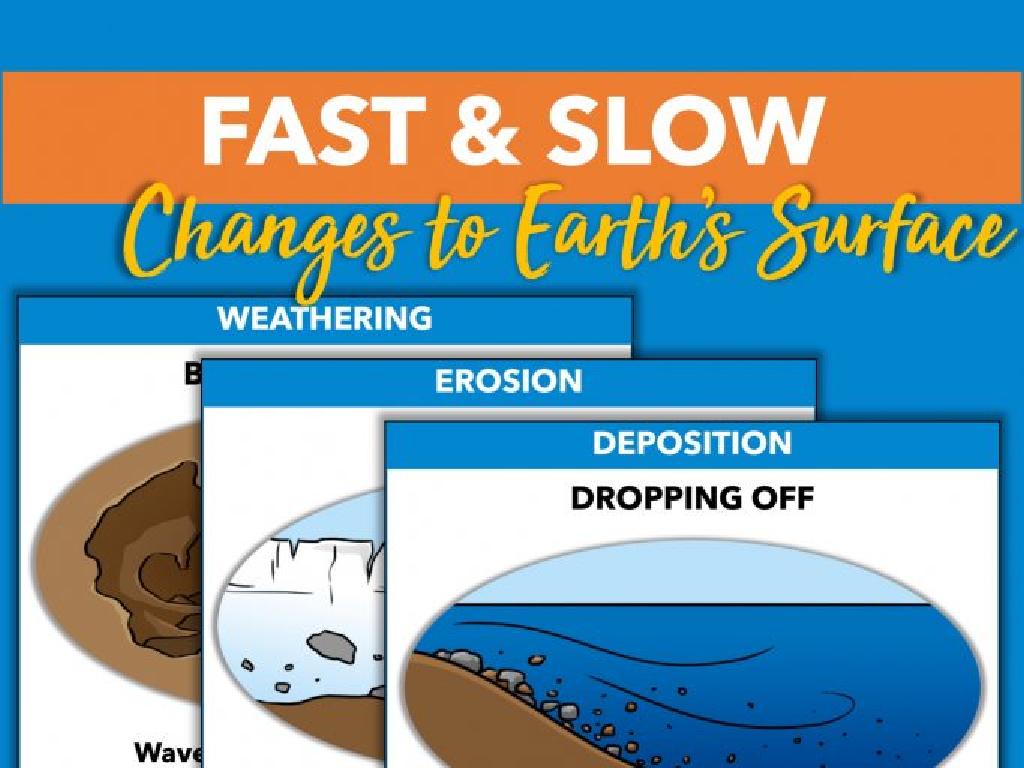Estimate To Solve Word Problems
Subject: Math
Grade: Sixth grade
Topic: Mixed Operations: Whole Numbers
Please LOG IN to download the presentation. Access is available to registered users only.
View More Content
Introduction to Estimation
– What is estimation?
– Estimation is finding a number close to the exact answer.
– Benefits of estimation skills
– It helps to quickly approximate without detailed calculations.
– Estimation in daily life
– Examples: Shopping budgets, measuring distances, or cooking.
– Estimation vs. exact calculation
|
This slide introduces the concept of estimation, which is a critical mathematical skill that allows students to find a number close to the exact answer without needing to calculate precisely. Discuss why being able to estimate is beneficial, such as saving time, checking the reasonableness of answers, and making quick decisions. Provide relatable real-life scenarios where estimation is used, like creating a budget for shopping, gauging the time needed to reach a destination, or determining the amount of ingredients needed for a recipe. Highlight the difference between estimation and exact calculation, emphasizing that estimation is a valuable tool when an approximate answer is sufficient.
Estimation Techniques in Word Problems
– Rounding numbers for estimation
– Round to the nearest 10, 100, or 1,000 to simplify numbers.
– Front-End Estimation method
– Use the leading digits for a quick estimate.
– Clustering to find average
– Group numbers close in value and find their average.
– Applying techniques to problems
|
This slide introduces students to various estimation techniques that are useful in solving word problems involving mixed operations with whole numbers. Rounding helps to simplify complex numbers to more manageable figures. Teach students how to round up or down based on the digit and place value. Front-End Estimation involves using the first digits of a number for a quick, rough estimate, which is particularly useful when dealing with large numbers. Clustering is a method where you group numbers that are close in value and estimate their average to find a solution. Encourage students to practice these techniques with real-world examples and to understand when each technique is most appropriate. Provide word problems that require these estimation methods to reinforce the concepts.
Estimation in Word Problems
– Read the problem thoroughly
– Understand the story and question
– Find key numbers and operations
– Look for important numerical information and what to do with them
– Estimate before calculating
– Use rounding to simplify numbers for a quick estimate
– Check reasonableness of answer
– After solving, compare the estimate with the actual answer to see if it makes sense
|
This slide is aimed at teaching students the importance of estimation in solving word problems. Start by emphasizing the need to read the problem carefully to understand what is being asked. Then, guide students to identify crucial numbers and the operations required by the problem. Encourage them to make an educated guess by rounding numbers and performing simplified operations to estimate the answer before solving it precisely. Finally, remind them to compare their estimate with the actual answer to check for reasonableness, which helps validate their solution and reinforces their understanding of estimation in practical use.
Estimation in Shopping: Quick Decisions
– Estimate total shopping cost
– Add up prices, rounding each to the nearest dollar
– Round to nearest dollar
– Use estimation for quick decisions
– Estimation avoids long calculations at the store
– Practice with real-life examples
– Example: Estimating the cost of school supplies
|
This slide aims to teach students the practical application of estimation in everyday life, such as when shopping. Start by explaining how to round the price of individual items to the nearest dollar and then add them up to estimate the total cost. Emphasize that estimation is a valuable skill for making quick decisions, especially when exact calculations are not necessary. Provide real-life examples, such as estimating the total cost of a list of school supplies, to make the concept relatable. Encourage students to practice by estimating costs of items they commonly buy or would like to purchase. This activity can be interactive by having students bring in flyers or advertisements and practice estimating the total cost of buying multiple items.
Estimation in Word Problems
– Practice estimation with problems
– Solve provided word problems using estimation techniques.
– Compare estimates to exact answers
– After solving, compare your estimated answer with the exact solution.
– Understand estimation benefits
– Grasp why estimation can be more practical than exact calculations.
– Use estimation in daily scenarios
– Discuss how estimation is useful in everyday life, like budgeting or cooking.
|
This slide is aimed at providing students with practice problems to apply estimation techniques in solving word problems. Encourage students to use rounding and other estimation strategies to find approximate answers quickly. After they have estimated the answers, they should solve the problems exactly to see how close their estimates were. Discuss the importance of estimation in real-life situations where an exact number is not necessary, and speed is more important. This will help them understand the relevance of estimation in daily life. Provide examples such as estimating the total cost while shopping or the time needed to complete a task.
Class Activity: Estimation Relay
– Teams work on estimation problems
– Each member solves a problem part
– Aim for correct estimates quickly
– Winning team finishes first with accuracy
|
This activity is designed to encourage collaboration and quick thinking as students work in teams to estimate and solve word problems. Divide the class into small groups and give each team a set of problems where each member is responsible for one part of the problem. Emphasize the importance of estimation to make solving complex problems more manageable. The goal is to be the first team to finish with correct estimates. Prepare 4-5 different sets of problems so that teams can rotate and try different challenges. This will help students see the practical application of estimation in solving larger problems and reinforce their understanding of mixed operations with whole numbers.
Estimation Techniques: Recap & Importance
– Review key estimation strategies
– Rounding numbers, front-end estimation, and using benchmarks
– Discuss estimation in daily life
– Estimation helps in budgeting, shopping, and time management
– Engage in a Q&A session
– Summarize estimation benefits
– Estimation saves time and simplifies complex calculations
|
As we conclude, let’s recap the main estimation techniques we’ve learned, such as rounding to the nearest ten or hundred, using front-end estimation, and applying benchmarks. Highlight how these methods are not just academic exercises but are actually used in everyday situations like making quick decisions while shopping or planning events. Encourage students to ask questions about anything they’re unsure of to clarify their understanding. Finally, summarize the benefits of estimation, emphasizing its role in making math more practical and approachable in real-life scenarios. Prepare to provide examples and answer questions to ensure students are comfortable with the concept.





